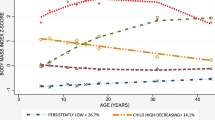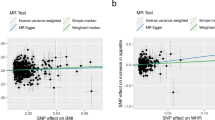Abstract
Background:
Obesity is known to be associated with increased prevalence of common mental disorders (for example, depression and anxiety), and there is evidence of age and gender differences in this relationship. However, categorisation of body mass index (BMI) and age has limited our ability to understand the nature of these differences. This study used continuous values of BMI and age to explore the shape of the association between common mental disorders and BMI and whether it varied with age, gender and education.
Method:
The analysis used cross-sectional data on 7043 adults from the English 2007 Adult Psychiatric Morbidity Survey. Common mental disorders were assessed using the revised Clinical Interview Schedule (CIS-R). Cubic splines allowed BMI and age to have non-linear effects in the logistic regression analysis.
Results:
BMI was strongly associated with the presence of common mental disorders, and there was clear evidence that this association varied with gender and age. In young women the probability of having a disorder increased as BMI increased, whereas in young men the relationship was U-shaped—probabilities were higher for both underweight and obese men. These associations diminished in older age groups, particularly when potential confounders such as physical health were taken into account. There was no evidence that the relationship varied with education.
Conclusions:
Age and gender differences must be taken into account when investigating the link between BMI or obesity and common mental disorders. Furthermore, results of studies that categorise BMI may be highly sensitive to the width of the ‘normal weight’ reference category.
This is a preview of subscription content, access via your institution
Access options
Subscribe to this journal
Receive 12 print issues and online access
$259.00 per year
only $21.58 per issue
Buy this article
- Purchase on Springer Link
- Instant access to full article PDF
Prices may be subject to local taxes which are calculated during checkout




Similar content being viewed by others
References
Atlantis E, Baker M . Obesity effects on depression: systematic review of epidemiological studies. Int J Obes 2008; 32: 881–891.
de Wit L, Luppino F, van Straten A, Penninx B, Zitman F, Cuijpers P . Depression and obesity: a meta-analysis of community-based studies. Psychiatry Res 2010; 178: 230–235.
Scott KM, Bruffaerts R, Simon GE, Alonso J, Angermeyer M, De Girolamo G et al. Obesity and mental disorders in the general population: results from the world mental health surveys. Int J Obes 2008; 32: 192–200.
Mather AA, Cox BJ, Enns MW, Sareen J . Associations of obesity with psychiatric disorders and suicidal behaviors in a nationally representative sample. J Psychosom Res 2009; 66: 277–285.
Luppino FS, de Wit LM, Bouvy PF, Stijnen T, Cuijpers P, Penninx BWJH et al. Overweight, obesity, and depression: a systematic review and meta-analysis of longitudinal studies. Arch Gen Psychiatry 2010; 67: 220–229.
de Wit LM, van Straten A, van Herten M, Penninx BWJH, Cuijpers P . Depression and body mass index, a u-shaped association. BMC Public Health 2009; 9: 14.
Zhao G, Ford ES, Dhingra S, Li C, Strine TW, Mokdad AH . Depression and anxiety among US adults: Associations with body mass index. Int J Obes 2009; 33: 257–266.
Heo M, Pietrobelli A, Fontaine KR, Sirey JA, Faith MS . Depressive mood and obesity in US adults: Comparison and moderation by sex, age, and race. Int J Obes 2006; 30: 513–519.
Chen Y, Jiang Y, Mao Y . Association between obesity and depression in Canadians. J Womens Health 2009; 18: 1687–1692.
National Centre for Social Research and University of Leicester. Adult Psychiatric Morbidity Survey, 2007 (data file). 2nd Edition. UK Data Archive: Colchester, Essex, April 2010. SN: 6379.
National Centre for Social Research. Adult psychiatric morbidity in England, 2007: Results of a household survey. National Centre for Social Research: London, 2009. Available at URL http://www.ic.nhs.uk/statistics-and-data-collections/mental-health/mental-health-surveys/adult-psychiatric-morbidity-in-england-2007:-results-of-a-household-survey (Accessed on 24 June 2009).
Lewis G, Pelosi AJ, Araya R, Dunn G . Measuring psychiatric disorder in the community: a standardized assessment for use by lay interviewers. Psychol Med 1992; 22: 465–486.
National Centre for Social Research. Adult psychiatric morbidity in England, 2007: Results of a household survey, Appendices and Glossary. National Centre for Social Research: London, 2009. Available at URL http://www.ic.nhs.uk/statistics-and-data-collections/mental-health/mental-health-surveys/adult-psychiatric-morbidity-in-england-2007:-results-of-a-household-survey (Accessed on 24 June 2009).
World Health Organization. The ICD-10 classification of mental and behavioural disorders: diagnostic criteria for research. World Health Organization: Geneva, 1993.
Harrell FE . Regression modeling strategies: with applications to linear models, logistic regression, and survival analysis. Springer-Verlag: New York, 2001.
World Health Organization. Obesity: Preventing and managing the global epidemic. World Health Organization: Geneva, 2000. Available at URL http://apps.who.int/bmi/index.jsp?introPage=intro_5.html (Accessed on 26 August 2009).
World Health Organization. AUDIT—The alcohol use disorders identification test: Guidelines for use in primary care (Second edition). World Health Organization: Geneva, 2001. Available at URL http://www.who.int/substance_abuse/publications/alcohol/en/index.html (Accessed on 28 August 2009).
Stockwell T, Sitharthan T, Mcgrath D, Lang E . The measurement of alcohol dependence and impaired control in community samples. Addiction 1994; 89: 167–174.
Korn EL, Graubard BI . Analysis of large health surveys - Accounting for the sampling design. J R Stat Soc Ser A-Stat Soc 1995; 158: 263–295.
Alzola C, Harrell F . An introduction to S and the Hmisc and Design libraries 2006. Available at URL http://biostat.mc.vanderbilt.edu/wiki/pub/Main/RS/sintro.pdf (Accessed on 30 August 2009).
Barry D, Pietrzak RH, Petry NM . Gender differences in associations between body mass index and DSM-IV mood and anxiety disorders: Results from the National Epidemiologic Survey on Alcohol and Related Conditions. Ann Epidemiol 2008; 18: 458–466.
McLaren L, Beck CA, Patten SB, Fick GH, Adair CE . The relationship between body mass index and mental health - A population-based study of the effects of the definition of mental health. Soc Psychiatry Psychiatr Epidemiol 2008; 43: 63–71.
Simon GE, Von Korff M, Saunders K, Miglioretti DL, Crane PK, van Belle G et al. Association between obesity and psychiatric disorders in the US adult population. Arch Gen Psychiatry 2006; 63: 824–830.
Royston P, Altman DG, Sauerbrei W . Dichotomizing continuous predictors in multiple regression: A bad idea. Stat Med 2006; 25: 127–141.
Gorber SC, Tremblay M, Moher D, Gorber B . A comparison of direct vs. self-report measures for assessing height, weight and body mass index: A systematic review. Obes Rev 2007; 8: 307–326.
Spencer EA, Appleby PN, Davey GK, Key TJ . Validity of self-reported height and weight in 4808 EPIC-Oxford participants. Public Health Nutr 2002; 5: 561–565.
Author information
Authors and Affiliations
Corresponding author
Ethics declarations
Competing interests
The authors declare no conflict of interest.
Rights and permissions
About this article
Cite this article
McCrea, R., Berger, Y. & King, M. Body mass index and common mental disorders: exploring the shape of the association and its moderation by age, gender and education. Int J Obes 36, 414–421 (2012). https://doi.org/10.1038/ijo.2011.65
Received:
Revised:
Accepted:
Published:
Issue Date:
DOI: https://doi.org/10.1038/ijo.2011.65
Keywords
This article is cited by
-
A megastudy on the predictability of personal information from facial images: Disentangling demographic and non-demographic signals
Scientific Reports (2023)
-
Association between obesity and common mental disorders in women: a population-based study in Southern Brazil
Social Psychiatry and Psychiatric Epidemiology (2023)
-
Substituting whole grains for refined grains and risk of developing psychological disorders in Iranian adults: YaHS and TAMYZ studies
Current Psychology (2023)
-
Mental distress along the cascade of care in managing hypertension
Scientific Reports (2022)
-
Lifetime self-reported arthritis is associated with elevated levels of mental health burden: A multi-national cross sectional study across 46 low- and middle-income countries
Scientific Reports (2017)



